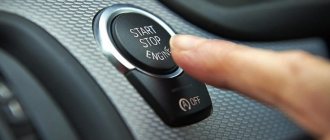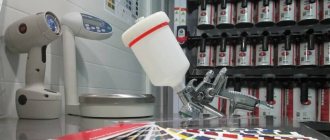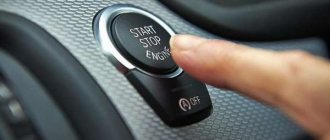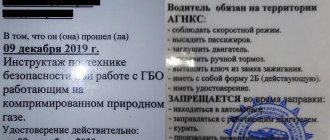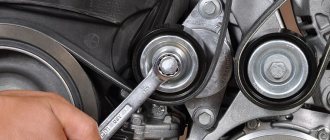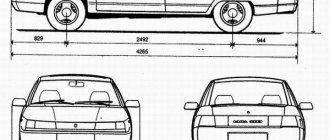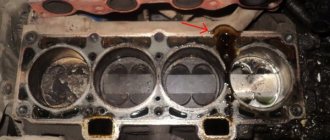A modern passenger car is filled with electronics that receive power through two wires - positive and negative, the latter often called “ground” or “ground”, and the metal body often acts as a wire. Symptoms of a bad ground on a VAZ 2114 often look like malfunctions of various systems, often not even related to electronics. But those who are familiar with the structure of the vehicle and the basics of electrical engineering quickly find the real reason.
What is “mass” in a car?
Electricity is the movement of electrons from the negative to the positive contact. Moreover, the switching of most components and systems of the car occurs via the positive wire, while all negative contacts are connected to ground. This scheme reduces the cost of wiring a car, because electrical wires are noticeably more expensive than structural steel, from which all body parts are made.
Despite the rather large electrical resistance of steel compared to copper and aluminum, due to the short length of the body, the influence of this parameter is insignificant, therefore, even when powerful electricity consumers are turned on, the voltage drop does not exceed 0.5 V. The voltage drop occurs strictly according to Ohm’s law , which states: “current is directly proportional to voltage and inversely proportional to the resistance of a circuit section.” Therefore, the higher the resistance, the less current at the same voltage, or the less voltage at the same current.
"Mass" diagram
Therefore, “ground” and “ground” mean not only the body itself, but also all the wires that connect it to energy consumers. This name appeared at the beginning of the twentieth century, when electricity and electrical devices began to enter the everyday life of most people. Although the name could have appeared earlier, when, during experiments with electricity, the negative contact was connected to a metal pin driven into the ground, which performed the function of grounding, that is, transferring excess energy to the ground.
Problems with bulk wires
How do problems with ground contacts manifest themselves?
Engine
If the ground wire from the ECM is oxidized or disconnected, this manifests itself in a spontaneous change in operating modes or the car suddenly stalls. Poor contact from the torpedo causes unstable engine operation at idle.
battery
If the contact is broken, the battery charge deteriorates, the starter speed decreases during startup, problems arise in the ECM, because the second ground wire from the battery goes there. To correct the violation, first check the tension of the nuts securing the thick wire to the engine.
To do this, the outer nut is loosened, the inner nut is checked and, if necessary, tightened. The outer nut is then screwed back on. The thin wire is the main conductor of the negative charge. In case of malfunctions, check its condition and the tightness of the nut on the housing, as well as the bolt on the battery terminal.
If you find a point with poor contact, completely disassemble the assembly, find all burnt and oxidized areas, clean and level all surfaces before reassembling. Crimp and solder all terminals.
ECM
Problems may arise due to the lack of a castle washer under the bar and a loose nut connecting the stud and wire in the factory configuration. Over time, due to the resulting backlash between the pin and the wire, voltage surges appear in the channels of several sensors. The result is an uncontrolled increase in engine speed when the fan is turned on.
ECU
Models with 1.5 engine. If the first ground connection from the computer (on the power steering shaft) is in poor contact, when turning on the headlights, direction indicators, sound signal, windshield washer and other consumers, deviations in the temperature and fuel level readings are possible.
Quick check. If you suspect that the problem lies in the ground point of the ECU, take alligator clips and attach one to the engine and the other to the ground in the passenger compartment. Start the car. If the problems disappear, repair the faulty contacts.
Models with 1.6 engine. If the first ground connection from the computer (inside the dashboard) is poorly connected, when the headlights or power windows are turned on, the windshield wiper and washer may start working or the door locking system may work.
If there is poor contact of the second ground terminal from the ECU (on the welded stud), when the side lights, headlights, and radiator fan are turned on, incorrect readings on the temperature and fuel level panel may occur (“jumping” arrows).
If problems occur, first check the first terminal and the connection on the M6 nut. If the nut is tightened normally, but the problem remains, check the second terminal - the ground point, grounding the panel to the welded stud (connection - M6 thread). The point is located in the middle part of the inner side of the engine shield. Usually the nut is screwed loosely and has to be tightened.
How does a bad “mass” manifest itself?
In most cases, a bad “ground” in a Lada 2114 looks like a malfunction of one of the systems. For example, the engine suddenly suddenly loses power, the radio plays a noticeably less loud sound, and the wipers move jerkily over a short distance and may freeze for several minutes. If the “mass” completely disappears, then the corresponding system completely stops working. This occurs due to the fact that additional resistance appears in the system's power circuit, which increases the total resistance of the energy consumer, and therefore reduces the current consumed by this system.
When the resistance becomes too great, the “mass” disappears and electrons stop moving through the circuit. Considering that in a modern car there is not a single system that functions without the participation of mechanical devices, determining the absence of “ground”, especially for an inexperienced driver, is not easy. If you know how to use a tester, then you can quickly determine the real cause of the breakdown, because the worse the “ground”, the less the supply voltage supplied to the electronic or electrical elements of the unit. Therefore, the symptoms of a bad “ground” on a VAZ 2110 are the same as on any other Lada or even a foreign car.
Checking the "mass"
Often, the lack of “mass” is completely identical in its manifestations to the lack of nutrition due to:
- broken wire;
- short circuit;
- blown fuse.
Despite the various reasons, the result of such malfunctions is the same - a decrease or cessation of the movement of electrons through the power circuit of the corresponding system.
Missing plus
The main reasons for the lack of a plus may be:
- Fuse or relay faulty. How to check was described above. If these parts fail, it is enough to simply replace them;
- Contacts are oxidized or damaged. You can see this with the naked eye. After cleaning from contaminants, the fuel pump should start working;
- Broken wiring. It is necessary to find the location of the break and eliminate it;
- The engine control unit blocks the fuel pump. There may be various errors on the on-board computer or during diagnostics with a scanner, as well as other symptoms of incorrect operation;
- The car alarm is not working properly and blocks the pump.
Most problems are easy to detect and fix yourself. But the last two require the intervention of a competent auto electrician. DIY repairs will only make the problem worse.
Source of the article: https://vaz-2114.info/vaz-2114-net-pitaniya-na-benzonasos/
The main places where bad “mass” appears and the reasons for this phenomenon
Here are the main places where bad “ground” appears:
- all contact points of the body and the wires suitable for it;
- contact terminals;
- wires under bend;
- threaded connections.
For these reasons, bad weight appears not only on the VAZ 2114, but also on any other vehicle. Catalysts or provocateurs for deterioration of conductivity along the negative power supply circuit are:
- corrosion caused by various factors, including electrochemical;
- loosening of threaded connections;
- high humidity and dust, due to which the contacts become covered with dirt;
- burning of contacts and terminals;
- mechanical damage to wires (fracture);
- disconnecting contacts and terminals;
- weakening of the elastic elements of the terminals;
- damage to the terminal locking mechanism.
A spit break is one of the reasons for the appearance of a bad “mass”
These reasons are relevant for any passenger car, regardless of engine type and year of manufacture.
Where is the mass from the engine to the body on the VAZ-2114: exact photos of the location
Experienced car enthusiast. I have an automotive education, namely: an engine repair mechanic. At the beginning of my career there was a VAZ-2107, then a BMW 5-series, a Toyota Supra and a right-hand drive MARK-2. Now the family has 2 cars: Peugeot 407 and Dodge Challenger 2016. I study each car from “A” to “Z”. I have a lot of experience and try to repair everything with my own hands.
How to find the place of a bad mass
The following algorithm of actions will help you find the place of bad contact in the negative circuit:
- identification of a faulty system;
- exclusion of mechanical defects;
- eliminating positive circuit power problems;
- confirmation of the problem via the negative power supply circuit;
- step-by-step check of the entire negative power circuit.
This algorithm is applicable to any car system, but on some systems it can be simplified by starting the test immediately from the point where the negative wire is connected to the body. But, we recommend sticking to it, because if the negative power supply line is faulty, then there is a high probability of problems in the mechanics and the positive circuit.
Identifying the problem unit or system
You will find detailed information about the design and principles of operation of the electrical and electronics of VAZ 2108–2215 cars here (wiring diagram of VAZ 2108–2115), so we will further talk about diagnosing faults of components that are part of the electrical circuit of these cars. Each of the systems is equipped with several connections to the body, which is the main negative conductor, so if several systems fail at the same time, then most likely the problem is not a bad “ground”, because they are connected to it in different places. The exception is failure or extremely poor operation of all systems caused by an oxidized negative terminal of the battery (battery) or its loose tightening.
Battery terminal oxidation
Remember, the symptoms of a bad ground on a VAZ 2114 Lada are often similar to other faults, but they obey the laws of electron motion, so if you have at least a little understanding of electrical engineering and know how to read diagrams, finding the cause will not be difficult for you.
Identifying a Problem Contact
After installing the malfunctioning system and making sure that the other systems connected to it by a common power circuit and one fuse are working properly, do this:
- Using the electrical diagram, look for the location of the terminals or blocks to which the negative wires from the body fit.
- Using a tester, measure the voltage on these contacts, placing the second probe of the tester on the positive terminal of the battery; if it corresponds to the norm for this contact, then move the second probe to the contact or terminal through which positive power is supplied to this system. Normal voltage on these contacts indicates a malfunction of the system as a whole or some of its units that are not related to the “ground”, and low voltage indicates problems in the positive power circuit.
- After making sure that the problem is a bad ground in the Lada 2114, or any other car, determine where the negative wire approaches the body. If there are contacts along this path, then measure the voltage between them and the positive terminal of the battery. As soon as the voltage rises to a normal value corresponding to the supply voltage of this system, then you have found the problem area. If the voltage remains low even at the point of contact with the body, but at other connection points it corresponds to the norm, then the terminal or body in the contact area is corroded or covered with dirt.
"Mass" is attached to the body
This technique is effective for carburetor and injection models. The main sign of a faulty negative circuit is normal voltage between the positive supply contact of the system and the negative of the battery, coupled with low voltage between both supply contacts of the system.
Relay test
We continue checking the VAZ 2114 fuel pump. The module in which the fuse and EBN relay are located is located in the dashboard, below, on the passenger seat side. To check the relay, remove the side panel and listen to how the relay behaves when the ignition key is turned.
There should be a click after which the fuel pump starts. The absence of a characteristic click indicates that the relay has failed or there is no contact with this device. What could be the reasons for this? The serviceability of the relay is checked as follows: take a piece of wire and close the contacts with it. If the pump starts working, then the problem should be looked for in the relay. It should be replaced.
Please note that the ends of the thick wire are inserted into the sockets where the gray and pink wires go. When the pump is operating normally, the sound of its motor should be audible in the cabin.
You can also check the relay by installing a device that is known to work.
How to fix a bad ground
The method of correcting the defect depends on the reason that caused it, but, in addition to restoring the “ground,” it is necessary to take measures that will prevent a recurrence of the breakdown in the future. If this is not done, then after some time the defect will return, and possibly in a more severe form.
Restoring contact between the terminal and the body
Here is the procedure to follow to restore contact: Disconnect the negative terminal of the battery. Unscrew the nut; if it is secured with a locknut, then both; if there is a bolt instead of a threaded pin, then unscrew it. Remove the washer and terminal from the threaded pin, or remove the bolt and move the terminal away from the contact point. Inspect the surfaces of the body and terminals, if there is dirt and corrosion on them, then clean them with any suitable product, for example, “Zinkar” (removes rust, converting it into metal) or Kontakt 60 (dissolves oxides and destroys their structure). Then remove the debris with a toothbrush and wipe the contact areas with isopropyl alcohol, then blow with air.
If the thickness of the corroded layer is 0.5 mm or more, then it is advisable to clean the area of the body and terminal with a metal brush or sandpaper, then treat it with Zinc. This will protect the contact surfaces from corrosion, so that the connection will work efficiently and for a long time. However, even treatment with Zinkar, which coats surfaces with a thin layer of zinc, is not a guarantee of long and trouble-free contact service, because it is exposed to air and steam. Therefore, after restoring contact, coat all parts with an acrylic primer for metal or nitro paint.
Rust converter "Tsinkar"
After drying and polymerization, a thin film is formed on the surface of the body and terminal, reliably protecting the parts from the effects of water vapor, which means that one of the most important elements of the corrosion process is eliminated.
Repairing a damaged wire
There are three ways to repair a damaged wire:
- completely replace;
- connect by twisting or soldering;
- connect with a crimp coupling.
For a complete replacement, find both contacts or terminals to which it fits, then disassemble them and first pull out the old conductor, then, after cleaning the ends, insert a new one. The advantage of this method is that the new wire has standard electrical resistance and will also last much longer than a twisted or soldered connection. The disadvantage of this method is that it is not always possible to get close to the terminals, and then pull out the old one and insert a new conductor without serious effort. This is especially true if it passes through a bundled bundle of other wires and to replace it you will have to unravel the entire bundle.
It is much easier to connect a damaged conductor by twisting or soldering, because you do not have to unravel the wiring harness, but this can be done if:
- it has enough length and shortening it by 3–5 cm will not affect anything;
- There is enough space near the damaged area to clean and then connect it.
If it is not possible to connect the wire by twisting, and other methods are not suitable, then you will have to insert a repair piece of a new wire, which will compensate for the reduction in length. For this, a piece of wire of a suitable cross-section, 10 cm long, is suitable. The main condition for high-quality contact at the twisting site is the correct procedure, that is, both ends need to be cleared of insulation, fluffed and inserted into each other, then wound across the wire. Be sure to cover the finished twist with heat shrink tubing.
Wiring harness
Remember, you can use soldering only where the wire is guaranteed not to be subject to even a slight bend. Otherwise, just twist.
A connection with a crimp coupling has higher strength and is also less prone to an increase in resistance due to oxidation of the wires than twisting. However, this will require high-quality couplings and a crimper - a special crimping device that can be purchased at auto parts stores. In addition, you can place the coupling only where there is enough space for stripping wires and working with a crimper. We recommend that such a connection be protected with heat-shrinkable tubing.
Signs of a fuel pump malfunction
- The car won't start. A possible reason could be a non-working or semi-working pump. It must create a certain pressure in the fuel system for normal operation. But the cause of the malfunction may lie elsewhere. In any case, you need to measure the pressure in the rail, check the spark and then draw the appropriate conclusions. More detailed information can be found here.
- The fuel pump does not buzz after turning the ignition key. Here, most likely, the issue lies in the wiring to the pump. A separate article is devoted to this problem.
- Interruptions in engine operation.
- The car jerks at low speed. Again, the fuel pump itself may be fine. The problem here is the small filter (mesh) underneath it.
How to protect contacts from corrosion
The main cause of corrosion is water, which can get onto the contacts either from a puddle through which the car drove at speed or in the form of condensation that falls on cold parts when hot air passes through them. Therefore, heat-shrinkable tubing or electrical tape, as well as painting with various paints, are only a partial solution to the problem. To prevent contacts from getting water from the road, install some kind of protection under them and avoid driving fast through puddles. To protect the contacts from condensation, reduce the amount of air movement through them.
Step by step replacement
4. The lamp is secured at the corners with four bolts. Eight-piece nuts.
6. Take a new lamp and install it. Namely, we get the bolts into the holes on the body.
9. Connect the power connector and close the hatch.
Expert opinion
It-Technology, Electrical power and electronics specialist
Ask questions to the “Specialist for modernization of energy generation systems”
Removing the rear light board To change the fuse, remove it from the block using tweezers, then install a new device in place of the old device. Ask, I'm in touch!


